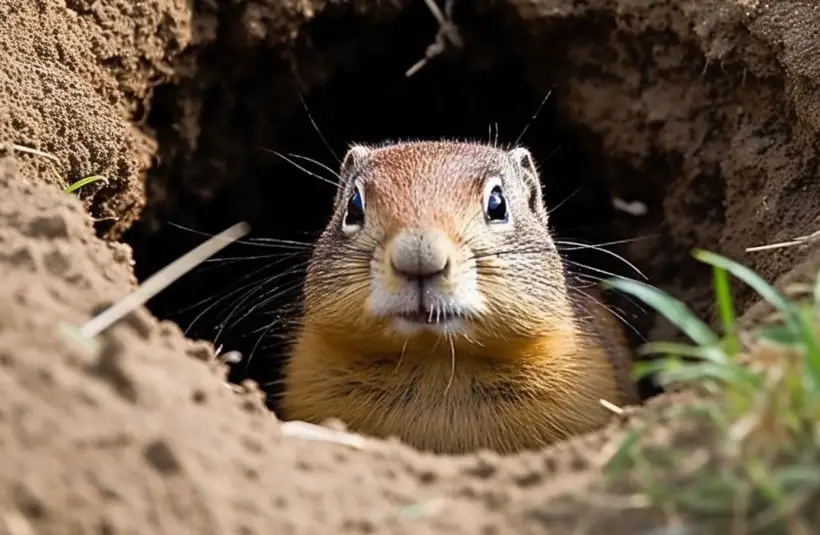What Sound Does A Gopher Make? (Everything You Need To Know!)
Gophers are burrowing rodents that are characterized by their unique methods of communication varying depending on the prevailing conditions. In pursuit of conserving these creatures, understanding gopher sounds helps keep them safe from predators, control their impact on the ecosystem and also facilitate wildlife management.
You are wondering what sounds does a gopher make? Gophers make different sounds depending on the situation and the message. They may scream, cry, squeak, or whisper to indicate danger. Gophers may whisper to indicate all calmness and no danger. They make chattering noises to mark territories and croon to attract mating partners.
Gophers spend most of their time underground in burrows feeding on plant roots and mating. They are well adapted for their burrowing lifestyle with ever-growing sharp incisors and strong hind legs. They make different sounds to communicate different situations such as when looking for mating partners and in danger.
This article reviews different types of vocalizations, their meaning, and how gophers use them in different situations to communicate.
Overview Of The Different Types Of Sounds That Gophers Make
Gophers make sounds using their vocals, known as vocalization sounds, to communicate with one another. They also make sounds by contact with two body parts without using any respiratory organs.

Vocalization Sounds
Vocalization sounds are the ones gophers make through their respiratory systems, such as the lungs and the vocal cords. These sounds are made out of modified air sounds with the vibration of the vocals in the voice box.
Vocal sounds include screaming, squeaking, and whistling. These sounds are made through the vibration of air at varying speeds and with the mouth opening and tongue in various twists and angles.
Non-Vocal Sounds
Non-vocal sounds are sounds made without the use of vocal cords. They are produced by means of hitting two parts together to produce a particular sound.
These sounds include the chattering noises made by gophers by hitting the upper and lower teeth together.
Explanation Of What Each Type Of Sound Means
Each sound made by gophers communicates a unique and specific message that fellow gophers understand in the same ecosystem. Let’s look at the vocalization types.

Warning Calls
Warning calls include whistles, screaming, whimpering or crying, and squeaking. By making these sounds, they warn their fellow gophers of impending danger from wildlife, animals and man.
They also use the same sounds to call for action in a specific direction to escape danger. These calls are deafening and of high pitch, signaling urgency, aggression, and speed.
If one of the gophers is caught by predators during pest prevention routines, they scream and squeak to alert the rest to save their lives.
When warning of a possible predator attack, gophers make various sounds of distressed emotions of fear and stress especially during pest control by humans.
Territorial Displays
Gophers prefer living alone in their territory unless they want to mate when they invite partners into their territory. To mark their territory, they make chattering noise, a non-vocal sound to communicate to any other rodents planning to intrude.
These sounds are made using their incisors by tapping each other continuously in an aggressive mood.
Mating Calls
Calls to mate are unique and are only used when the male is ready for mating. The male often leaves the tunnel, stands at its entrance, and starts crooning or purring to attract a female partner.

These mating calls are calm and are meant to attract and lure a partner into living together in the burrow systems and starting mating.
The female responds by purring until they meet and stay together during the mating and parenting period if their animal behavior aligns.
Description Of How Gophers Use Sound To Communicate With One Another
Like other mammals in this class, they use sound to relay different messages without exposing their hideouts as communication methods. Most of the time, they use sound with a high pitch so that human beings cannot hear them.
Gophers take a turn in communicating. One gopher makes the sound and awaits a response from other gophers. In most cases, the one sending a message has to scream until a response is heard.

Gopher vocalizations are projected so they can be heard by others deep in the tunnels. They also like to communicate at night when less human activity may cause noise interference.
At night the wind is primarily calm; thus, the sound will not be swept in the wrong direction. Once a gopher receives a sound, it may respond by approaching the source if it’s a mating or celebratory sound.
However, if the sound is a warning tone, they run and escape away from the source of the sound.
Tips For Identifying Gopher Sounds
In the forest and fields, sometimes it becomes hard identifying gopher sounds from other sounds made by other rodents and birds. To quickly identify gopher sounds, follow these two guidelines.

What To Listen To
Gophers will scream, squeak, cry, whistle, croon, or make chattering sounds. Therefore, it is better to concentrate on these possible sound outcomes while trying to identify their sounds.
If you hear barks, you ignore them and focus on a scream or a chattering sound.
Where To Look For
Since we are looking for sounds made by gophers, it is prudent to first look for signs of gophers’ territorial behavior and existence in the area. Check for the following physical features that indicate gophers’ presence.
- Underground tunnels and channels
- Mounds on the soil surface
- Wilting or dried crops
- Waste and nesting materials heaped in mounds
These are indicators that gophers are living in that area. You can now listen to the sounds coming from that region.
Differences Between Gopher Sounds And Other Similar Animal Sounds
Even if gopher species are similar to other rodents, especially the ground squirrels and moles, they have distinctive sounds and vocalizations. This helps avoid confusion, where a gopher may pick the wrong message from different animals such as squirrels.

1. Ground Squirrels
Unlike gophers, ground squirrels do not use their mouth to make sounds. They make sounds deep within their chests and then regulate their breathing pattern.
Apart from the common vocalizations, ground squirrels have a unique way of making sounds. They communicate by flicking their tails and stomping their feet.
It’s hard to read the sounds made by ground squirrels by looking at their mouths, as is the case for cows when ”cowing”. It’s only possible by checking how their breathing changes with rapid expansion and contraction of muscles in case the squirrel is panting or moaning.
With their breath moderation, ground squirrels make several sounds, including;
- Rattling and screeching
Ground squirrels rattle and screech to attract prey especially at dusk. These sounds are fairly soft and calm to entice prey.
- Long Quaa’ Moaning
They also moan with a long quaa’ sound when the threat upon them is great. For example, if they are under attack by wild foxes and wolves, ground squirrels make strong and high pitch moans.

The sounds depend on the level of threat and one may hear an extended bark as ground squirrels warn the others.
- Kuk-Kuk (shortened bark)
Ground squirrels make the Kuk sound under the following situations.
- When it is being attacked by other animals/predators
- When scared of a predator or incoming danger
- When being chased by other animals
- When alerting other squirrels of its presence around foreign territories
Ground squirrels make other sounds such as Muk-Muk, seet-bark and alarm warning calls. Female ground squirrels make sounds of a higher pitch compared to gophers.
2. Moles
Moles make sounds depending on the existing situations. If the mole is in danger or under attack, it makes a high-pitched squeal many refer to as screaming.
Unlike gophers, moles communicate by making humming sounds unique to moles only to avoid trapping. When angry or aggressive, they make hissing sounds and bite their teeth together.
Gopher Vocalization Recordings – Where To Find The Recordings
As a means of preservation of gophers’ history, some of the researchers in wildlife management recorded their sounds for future reference.

These audios have been protected by Creative Commons Attribution-Noncommercial-No Derivative Works 3.0 United States License under the copyright regulations.
Some recordings have not been recorded as the work is in progress. However, most of the gophers’ sounds have been recorded in the titles of the Acoustic Atlas, which has a total of 3,133 recordings of different animals.
For example, the sound of a Mazama Pocket Gopher is found in the Acoustic Atlas Organization library as number 2,108 on the list.
You may also find recordings online on YouTube as researchers document their recordings or by pest control companies in Mexico and Central America. For example, click the link below to listen to gophers squeaking.
FAQs
Below are some frequently asked questions about gophers and their vocalizations.
Q: Can Gophers Make Any Other Sounds Besides Vocalizations?
Yes. Gophers can make chattering sounds with their teeth. They move the teeth up and down, grinding them against each other, indicating discomfort. The chattering sound is not vocal as it originated from the teeth.
Q: How Loud Are Gopher Vocalizations?
Depending on the situation, gophers can make very high-pitched sounds known as squeaks. It is recorded that gophers make sounds that reach up to 48 kilohertz.
Conclusion
Gophers make vocal sounds such as screaming, squeaking, whistling, and crooning to convey different messages. They also make non-vocal sounds like chattering noises to mark territories.
These sounds help gophers communicate within their ecosystem. Homeowners and pest control experts can understand what different sounds mean, while trying to control them together with the backyard pests such as porcupines and groundhogs.
For further research on gopher communication and behavior, study different researches, like Mazama Pocket Gopher vocalization.




